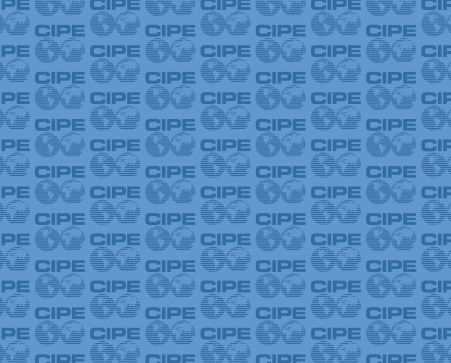
Ronald Coase was one of the most influential economists of the 20th century. As important as his theoretical contributions was the simple but profound idea of moving away from “blackboard economics” to look at real-world problems and how institutions actually work. This is an insight that informs our work at CIPE, and which influenced many new ideas and approaches in economics over Coase’s long working life (he published his last book at the age of 101, a year before his death in 2013).
On March 27-28, the Ronald Coase Institute and CIPE honored these contributions with a conference highlighting research and policy in the Coasean tradition, featuring Nobel laureates Kenneth Arrow and Oliver Williamson, distinguished senior scholars and practitioners, and young alumni of the Ronald Coase Institute.
When Coase began his career, academic economists had a tendency to “assume away” real-world complexity, building elegant theoretical models that simply ignored many of the most important aspects of economic life. Coase made studying these complexities the focus of his work.
In his seminal 1937 paper “The Nature of the Firm,” Coase set out to answer a simple question: why do firms exist? Why would an entrepreneur hire employees rather than contracting out to an efficient market for any goods and services they needed? The answer to this question, according to Coase, was “transaction costs.” Even when a market is efficient, using the market is not free — it takes time, resources, and expertise to find suppliers, negotiate contracts, oversee that the work is carried out, and enforce breaches of the contract terms.
The role of transaction costs turned out to be the key to understanding how all sorts of institutions — such as laws, regulations, social norms, cultural perceptions, and ideology — shape the economy and economic life. Coase’s work helped to integrate the formal and technical innovations of neoclassical “blackboard” economics with the focus on real-world inquiry found in the older political economy and economic history traditions, forging the discipline now known as New Institutional Economics and laying key conceptual groundwork for approaches looking at how the law, geography, governance, information, and human behavior affect economic processes.
The conference highlighted the diverse ways that Coase-inspired research continues to shape policy today. In developing countries, which face some of the most pressing economic challenges of our time, transaction costs are huge and institutions are often weak. To make progress — to come up with the right advice and make sure development interventions are effective — requires carefully studying the size and nature of these costs, and not just guessing, argued Philip Keefer of the World Bank. In particular, transaction costs between citizens and government can make collective action difficult in developing countries, creating barriers to good governance and stymieing attempts at reform.
Papers presented at the conference showed both the breadth of Coase-inspired research and its practical applications, covering everything from the effect of conflict minerals regulation on artisanal miners in the Democratic Republic of Congo to economic insights from the market for men’s razors.
Many of these insights focused on the economic reform process — attempts to improve the institutions that shape economies. Sebastian Galiani of the University of Maryland described the dynamics of structural reforms in countries like Argentina and Greece. He showed that when external organizations push for more sweeping reforms, they may be more likely to be reversed without credible commitment mechanisms. Dalibor Rohac showed this theory in action in Egypt, where imposed attempts to reform the country’s hugely expensive, distorting, and regressive subsidies have repeatedly been rolled back by pressure from entrenched local interests.
Several Coase Institute scholars explained how they used Coasean approaches to help understand China’s complex and changing economy. Why do local governments in China spend so much on welfare benefits, when they are not required to? Meina Cai argued that these payments act as a form of deferred compensation for rural residents whose land was taken to fuel economic development. Why has China pulled so far ahead of India in terms of per capita income? Colin Xu suggests that it is because of Indian labor regulations that keep Indian firms small, limiting economies of scale. This is no minor issue: the average Chinese worker now earns almost two and a half times more than the average Indian, even though India was richer than China in the 1960s.
With its practical focus, Coasean research does not just help to understand economic and political problems, but suggests how to improve the policies aimed at addressing them. This is what makes New Institutional Economics such an influential part of CIPE’s work — its focus on understanding how things work and why before suggesting solutions.
One running theme of the conference was that outside interventions, whether through aid or conditional lending, are rarely enough to sustain true long-term economic reform in any country. This is why CIPE has always argued that democracy and free markets are interconnected: a market economy cannot function well without democratic institutions, and democracy cannot flourish in the absence of free markets.
At the concluding panel on experience from the field, Mary Shirley, head of the Ronald Coase Institute, suggested that the foundations for reform are built by local scholars looking at real-world institutional questions in their own countries — which is why her organization supports research fellows from developing and transition countries. CIPE, for its part, will continue working to help reformers put their ideas into practice.
Jon Custer is a Digital Communications Specialist at CIPE.
Published Date: April 08, 2015